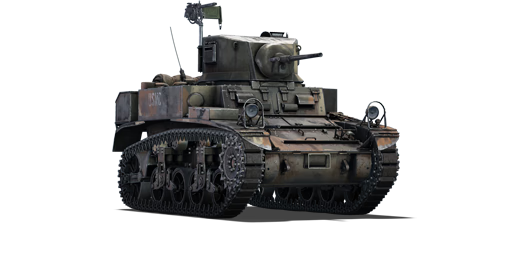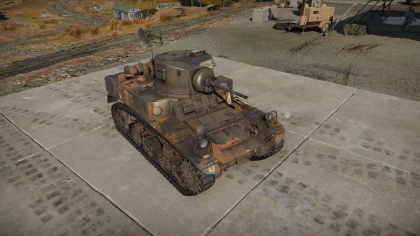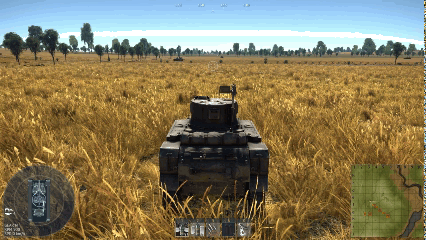M3A1 (USMC)
Contents
| This page is about the American light tank M3A1 (USMC). For other uses, see M3 (Disambiguation). |
Description
The Light Tank M3A1 Stuart (USMC) is a rank I American light tank
with a battle rating of 2.0 (AB) and 2.3 (RB/SB). It was one of the first American tanks to be released with the American ground tree in Update 1.45 "Steel Generals" and is essentially identical to the M3A1 in the tech tree. At the time of writing the M3A1 USMC is available in the US beginners pack on the Gaijin Store.
General info
Survivability and armour
Being a light tank the M3A1 has fairly thin armour, it can generally protect against most machine guns and some smaller (20mm) cannons, but will usually not stand up against the main weapons of most enemy tanks at its BR. There is a fair amount of empty space inside the tank, this means that some poorly placed shots can go through your tank without causing much damage.
Armour type:
- Rolled homogeneous armour
- Cast homogeneous armour (Gun mantlet)
| Armour | Front | Sides | Rear | Roof |
|---|---|---|---|---|
| Hull | 38.1 mm (18°) Driver Port
15.8 mm (69°) Front Glacis |
25.4 mm | 25.4 mm | 12.7 mm |
| Turret | 50.8 mm | 31.8 mm | 31.8 mm | 12.7 mm |
Mobility
The M3A1 USMC has competitive mobility with a ratio of 20.8hp for 1 ton, at lower speeds (5-10km/h) the turning can feel rater sluggish, but once a bit of forward movement is applied and the speed is increased the turning will feel much smoother and faster. The forward drive of the M3A1 can max out at 47km/h off road and 58km/h on road which will usually allow you to reach capture points or desirable camping spots quickly, The 6km/h reverse speed of the M3A1 is certainly usable in most situations.
Armaments
Main armament
Main weapon on the M3A1 is a 37mm M6 cannon featuring two rounds, AP & APCBC. This is a fairly standard gun for early American tanks as it is also featured on the M5A1, M22 & LVT(A)(1) although some of these vehicles also include a HE round that the M3A1 lacks.
| 37 mm M6 | |||||
|---|---|---|---|---|---|
| Ammo Capacity | Vertical
guidance |
Horizontal
guidance |
Stabilizer | ||
| 106 | -10°/+20° | ±180° | Vertical | ||
| Turret rotation speed (°/s) | |||||
| Mode | Stock | Upgraded | Prior + Full crew | Prior + Expert qualif. | Prior + Ace qualif. |
| Arcade | 11.90 | 16.50 | 20.00 | 22.10 | 23.50 |
| Realistic | 11.90 | 14.00 | 17.00 | 18.80 | 20.00 |
| Reloading rate (seconds) | |||||
| Stock | Prior + Full crew | Prior + Expert qualif. | Prior + Ace qualif. | ||
| 3.77 | 3.33 | 3.07 | 2.90 | ||
Ammunition
| Penetration statistics | |||||||
|---|---|---|---|---|---|---|---|
| Ammunition | Type of
warhead |
Penetration in mm @ 90° | |||||
| 10m | 100m | 500m | 1000m | 1500m | 2000m | ||
| M74B1 | AP | 79 | 76 | 65 | 54 | 45 | 37 |
| M51B1/B2 | APCBC | 87 | 84 | 73 | 60 | 50 | 41 |
| Shell details | |||||||||
|---|---|---|---|---|---|---|---|---|---|
| Ammunition | Velocity
in m/s |
Projectile
Mass in kg |
Fuse delay
in m: |
Fuse sensitivity
in mm: |
Explosive Mass in g (TNT equivalent): | Normalization At 30°
from horizontal: |
Ricochet: | ||
| 0% | 50% | 100% | |||||||
| M74B1 | 883 | 0.87 | N/A | N/A | N/A | -1° | 47° | 60° | 65° |
| M51B1/B2 | 883 | 0.87 | N/A | N/A | N/A | +4° | 48° | 63° | 71° |
| Full
ammo |
1st
rack empty |
2nd
rack empty |
3rd
rack empty |
Visual
discrepancy |
|---|---|---|---|---|
| 106 | 71 (+35) | 36 (+70) | 1 (+105) | No |
Machine guns
The M3A1 employs a turret top MG and a Coaxial MG, both of which are the same 7.62mm M1919A4 type, these guns are limited to a single AP & T belt type with up too 10mm of penetration.
| 7.62 mm M1919A4 | ||||||
|---|---|---|---|---|---|---|
| Coaxial mount | ||||||
| Capacity (Belt capacity) | Fire rate
(shots/minute) |
Vertical
guidance |
Horizontal
guidance | |||
| 3,200 (250) | 500 | N/A | N/A | |||
| Pintle mount | ||||||
| Capacity (Belt capacity) | Fire rate
(shots/minute) |
Vertical
guidance |
Horizontal
guidance | |||
| 3,000 (250) | 500 | -5°/+70° | ±60° | |||
Usage in battles
Due to its light armour it is advisable not to use the M3A1 USMC frontally at closer ranges, especially not against higher rated enemy vehicles that will go through your strongest frontal armour (50.8mm) without issue. The ideal tactic to use is to employ your competitive speed to flank the enemy and find a position that will allow you to attack them will little resistance, even in a match against higher rated enemy vehicles your rounds will have no issue going through the side armour of said enemy vehicles, common maps such as Eastern Europe and Cargo Port offer clear opportunity's to flank the enemy vehicles with good amounts of cover, this is especially clear on Eastern Europe where you can flank on the other side of the river that runs through the map, this puts you at close range to the side of enemy vehicles, allowing you to prevent them reaching capture points such as the central B point.
To take down enemy vehicles it is advisable to destroy both their turret and engine to prevent escape and stop them engaging you or your allies, due to the fast reload (at best 2.9s) you can hit both parts of an enemy quickly, usually before they can fire back, if they are still not dead after the gun and engine have been hit, shots into the crew compartment should finish the job, but most enemy's are usually killed by the first 2 shots, it is common for any side shot against an enemy to pen and cause a fair level of damage, even if the enemy is not killed your fast reload will grant you a second chance quickly to place an adjusted shot into the enemy. Even at longer ranges the M3A1 USMC can be a competent sniper, especially if facing lighter vehicles with flat armour or the side armour of a targeted enemy, firing from long range is another way to ensure that your light armour does not hold you back, being at long range will usually prevent or make it difficult for enemy's to successfully hit your vehicle.
Specific enemy vehicles that bear mentioning are firstly any Germans with the 20mm KwK/FlaK38 cannon, this gun might be small but can have up too 64mm of pen, which is enough to go through the M3A1 USMC at almost any point, these guns can also fire 10 rounds at 280 rounds/min before having to reload the clip, this means that they will very easily take out your crew before you have a chance to respond, as far as countering the best chance you have is to angle your frontal armour which can make it difficult for the PzGr 40 rounds to pen. The Russian T-50 and T-126 are vehicles you will also see commonly, these have fairly thick & angled frontal armour that will prevent you from easily getting through, these tanks also poses an APHEBC round that will destroy you in one shot with little difficulty, to counter you should use your speed to attempt to get a side shot into either the turret or engine, if the T-50 cannot move you can outrun its turret and finish it without much difficulty.
Pros and cons
Pros:
- Frontal Armour useful against MG's and light Cannons
- Competitive mobility
- Reliable gun with a good rate of fire
- Ammo has good penetration
- Lots of empty space, so poorly aimed shots tend to not do much damage
- Comes with "USMC" decal
Cons:
- Crew can all be killed by a well placed shot
- Brakes are weak
- Turning is sluggish at slower speeds
- No AP ammunition with HE filler
History
The British were the first to use the M3 Stuart in Africa in 1941, using it in Operation Crusader. However, the result ended with heavy losses, due to the better training the German Afrika Korps had compared to the British tank doctrine. The encounter also pointed out many flaws in the M3, mainly the cramped interior and limited operational range, but was praised for its high mobility and reliability when compared to the British contemporary designs. In 1942, the Stuarts were generally kept as recon units rather than combat units, and some were even modified to improve speed and range by removing the turret, and others were converted to armoured personnel carriers and command vehicles. Though the British used it extensively, it was still in small proportion compared to American usage. The Soviet Union was also another user of the M3 but found it unfavourable due to their own logistics, plus it was not made to withstand the Russian Rasputitsa or even the winter. The Soviet eventually turned down any more offers for the Stuart by 1943. The M3s also supported the British and Chinese forces in Asia against the Japanese Army, and also France and Yugoslavia in Europe against the German Wehrmacht.
The Americans used it widely in both operational theatres. In the Pacific, the M3s were the first tanks America used in a tank vs. tank operation against the Imperial Japanese Army, where five M3s fought Type 95 Ha-Gos in the Phillippines. Though the Stuarts were newer than the Japanese tank designs by about five years, they were seen as equal in performance and firepower, but the M3 benefited by the support of the American industry arm. The Stuarts served in the Pacific slightly better than its heavier counterparts such as the M4 Shermans due to its lighter weight and manoeuvrability in the poor jungle terrain, but the M3 Stuarts in the Pacific were gradually replaced by M4 Shermans due to heavy losses from its thinner armour. The M3 was also some of the first US tanks to be converted into flamethrower tanks, named as the "Satan". The Satan tanks provided favourable results to the concept of a flamethrower tank and were replaced by flamethrower-equipped M4 Shermans in 1945.
In Europe, the M3 formed a large part of the American tank battalions, though following the British path by sidelining the Stuarts from combat duties after heavy losses and to serve alongside Shermans as scouting units. A typical tank battalion for the US Army consisted of three companies of Shermans and one of Stuarts. Other than scouting, the M3s were also used in cavalry roles and infantry support since their cannon are unable to compete with the German tank designs. Despite their dwindling capabilities in battle, the M3 was kept in service up until the end of the war due to the large production numbers.
After World War II, the Stuarts were given out as cheap surplus, countries such as China, India, and Pakistan picked up a few and used them in their conflicts. Portuguese also picked up a few M3s for the war in Angola, and the South African Corps continued using the Stuarts until 1955, where some were still kept in service until 1968 due to available parts. Today, Paraguay is still a user of the M3 light tanks, though as the only tracked armour used in the country.
The Stuart light tank design was also quite versatile that it was made into different variants for different roles on the battlefield. It served as an infantry support vehicle as to the 75mm GMC M8 and experiments were also taken to see if it could be adapted to an anti-aircraft gun and a flamethrower as well. However, the M3 was becoming an ageing design with inferior armour, cramped interior layout, and a small 37 mm gun, so a program to replace the light tank began in 1943 and became the M24 Chaffee, which would eventually replace the M3 Light Tank mostly after World War II.
The USMC variant represents an M3A1 used by the United States Marines Corps.
In-game description
"Production of the M3A1 Stuart modification got underway in April 1942, with its primary changes affecting turret construction. The turret was a horseshoe-shaped M3, though it did not have a cupola, and two triangular hatches on its roof served as exits for the crew. The gunner and reloader had periscopes. The turret rotated using a power traverse as opposed to the manually rotated M3. Its faster rotation speed required changes in its construction, in particular a basket fitted with seats for the crew members.
The M23 mantlet was fitted with a 37 mm M6 cannon featuring a gyro stabilizer that significantly boosted accuracy while on the move. That did, however, require more training for gunners, a difficult assignment under battlefield conditions. The sponson-mounted immobile M1919A4 machine guns were replaced with additional ammunition storage, pushing the tank's capacity to 116 shells and 6,400 bullets.
From April to August of 1942 the M3A1 was produced alongside the M3. Changes were made gradually, meaning that some later M3s featured welded bodies and new turrets. They lacked, however, the basket and power traverse, and were called Stuart Hybrids. Some early M3A1s had sponson-mounted machine guns (the intervening models plugged up the openings) and riveted bodies.
By the end of February 1943, 4,621 M3A1s had been assembled, 211 of them with the Guiberson T-1020-4 engines (called Stuart IVs by the British). It is worth noting that the M3A1s with welded bodies should have been designated M3A2s, though that never actually happened."
Media
https://www.youtube.com/watch?v=2wfjMlKtALw
See also
Links to the articles on the War Thunder Wiki that you think will be useful for the reader, for example:
- reference to the series of the vehicles;
- links to approximate analogues of other nations and research trees.
External links
Paste links to sources and external resources, such as:
- topic on the official game forum;
- encyclopedia page on the tank;
- other literature.
| USA light tanks | |
|---|---|
| LVT | LVT(A)(1) · ○LVT(A)(1) · LVT(A)(4) |
| M2 | M2A2 · M2A4 · M2A4 (1st Arm.Div.) |
| M3/M5 Stuart | M3 Stuart · M3A1 Stuart · M3A1 (USMC) · M5A1 · M5A1 TD · ▃Stuart VI (5th CAD) |
| M22 Locust | M22 |
| M24 Chaffee | M24 · M24 (TL) |
| M18 Hellcat | M18 GMC · M18 "Black Cat" · Super Hellcat |
| M41 Walker Bulldog | M41A1 |
| M551 Sheridan | M551 · M551(76) |
| M3 Bradley | M3 Bradley · M3A3 Bradley |
| Wheeled | M8 LAC · T18E2 · M1128 · M1128 Wolfpack |
| Other | M8A1 GMC · T92 · T114 · HSTV-L · CCVL · XM8 · XM800T · AGS |
| USA premium ground vehicles | |
|---|---|
| Light tanks | LVT(A)(4) · M2A4 (1st Arm.Div.) · M3A1 (USMC) · ▃Stuart VI (5th CAD) · M8 LAC · M8A1 GMC |
| M18 "Black Cat" · Super Hellcat · T18E2 · M551(76) · T114 · M1128 Wolfpack | |
| Medium tanks | ▃Grant I · M4A5 · Calliope · T20 · M26 T99 · M26E1 · M46 "Tiger" · T54E1 · T54E2 · ▃Magach 3 (ERA) · M728 CEV |
| XM1 (GM) · XM1 (Chrysler) · M1 KVT · M1A1 Click-Bait | |
| Heavy tanks | T14 · Cobra King · M6A2E1 · T29 · T30 |
| Tank destroyers | T28 · T55E1 |






